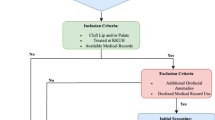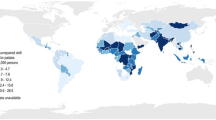Abstract
Background
The burden of cleft care throughout a patients’ life includes plastic surgery, otolaryngology (ENT), speech therapy and dental and orthodontic care, all of which are required to achieve an optimal outcome. We aimed to determine the burden of care across multiple specialties in babies born with cleft lip and/or palate up to the age of 21 years. We compare the outcomes to two larger multi-centre studies: the Americleft and Eurocleft studies.
Methods
The regional database was used and all babies born between 1988 and 1995 were included. Medical records and the cleft database were used to determine cleft subtype, operations and outpatient appointments (plastics, ENT, dental, orthodontic, speech and language), hospital stay and length of follow-up.
Results
A total of 321 patients with cleft lip and/or palate were born between 1988 and 1995. Complete data was available for 106 (33%). Primary and secondary plastic surgery operations increased with increasing cleft severity. Secondary surgery was highest in unilateral cleft lip and palate (UCLP)—64%. Total inpatient stay for plastic surgery operations was highest for bilateral cleft lip and palate (BCLP) (16.4 days) compared with 7.7 for incomplete cleft palate (iCPO). The outpatient burden for all specialities was highest in complex cleft patients: 48.5 appointments compared with 25.5 for children with an incomplete cleft palate. Follow-up time increased from 14.2 to 20.5 years.
Conclusions
Unsurprisingly, both the inpatient and outpatient burdens of care are influenced by the complexity of the cleft and increase with worsening severity. Our results will help inform parents of the likely trajectory their child will face when diagnosed with each subtype of cleft. The 2014 data shows that modern cleft care is changing; a combination of reduced hospital stay and the addition of streamlined outpatient appointments will both be of great benefit. The influence of modern day life will hopefully reduce the associated burden that has been highlighted in this paper and it is vital the benefits of modernisation are communicated to parents as well.
Level of evidence: Level III, risk/prognostic study.


Similar content being viewed by others
References
Wehby G, Cassell CH (2010) The impact of orofacial clefts on quality of life and health care use and costs. Oral Dis 16(1):3–10
Sandy J, Williams A, Mildinhall S, Murphy T, Bearn D, Shaw B, Sell D, Devlin B, Murray J (1998) The Clinical Standards Advisory Group (CSAG) cleft lip and palate study. Br J Orthod 25:21–30
Semb B, Brattström V, Mølsted K, Prahl-Andersen B, Shaw WC (2005a) The Eurocleft study: intercenter study of treatment outcome in patients with complete cleft lip and palate. Part 1: introduction and treatment experience. Cleft Palate Craniofac J 42(1):64–68
Sitzman TJ, Mara CA, Long RE, Daskalogiannakis J, Russell KA, Mercado AM, Hathaway RR, Carle AC, Semb G, Shaw WC (2015) The Americleft project: burden of care from secondary surgery. Plast Reconstr Surg Glob Open 3(7):E442
Semb B, Brattström V, Mølsted K, Prahl-Andersen B, Zuurbier P, Rumsey N, Shaw WC (2005b) The Eurocleft study: intercenter study of treatment outcome in patients with complete cleft lip and palate. Part 4: relationship among treatment outcome, patient/parent satisfaction, and the burden of care. Cleft Palate Craniofac J 42(1):83–92
Sitzman TJ, Coyne SM, Britto MT (2016) The burden of care for children with unilateral cleft lip: a systematic review of revision surgery. Cleft Palate Craniofac J 53(4):e84–e94
Cassell CH, Meyer RE (2008) Timeliness of services during the first two years of life among Medicaid- eligible children with orofacial clefts in North Carolina, 1995–2002. North Carolina State Centre for Health Statistics Studies. Available at: http://www.schs.state.nc.us/SCHS/pdf/SCHS157.pdf. Accessed Apr 2019
Boulet SL, Grosse SD, Honein MA, Correa-Villaseñor A (2009) Children with orofacial clefts: health-care use and costs among a privately insured population. Public Health Rep 124:447–453
Author information
Authors and Affiliations
Corresponding author
Ethics declarations
Conflict of interest
Serena Martin, Michael McBride, Kevin McGarry and Chris Hill declare that they have no conflict of interest.
Ethical approval
This study is compliant with the Helsinki declaration.
Patient consent
Patient or parental consent was obtained if required.
Additional information
Publisher’s note
Springer Nature remains neutral with regard to jurisdictional claims in published maps and institutional affiliations.
Rights and permissions
About this article
Cite this article
Martin, S., McBride, M., McGarry, K. et al. Burden of cleft surgery—a 21-year follow-up of patients with cleft lip and palate. Eur J Plast Surg 43, 365–370 (2020). https://doi.org/10.1007/s00238-020-01633-z
Received:
Accepted:
Published:
Issue Date:
DOI: https://doi.org/10.1007/s00238-020-01633-z




